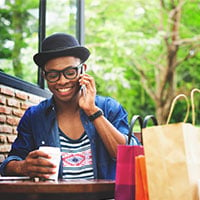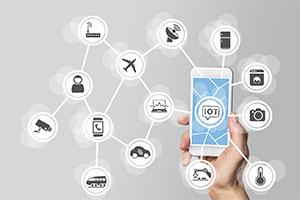The opportunity to boost your loyalty program and track real consumer habits is bigger than ever when you leverage today’s internet of things. With smartphones, fitness trackers, smart watches and other portable electronics, the consumer behavior data is there. Use it to your advantage to track and improve your consumer loyalty program.
Here are three big opportunities the "Internet of Things", or IoT, creates to augment your loyalty program:
Start with Your Customer
 Understand your consumer. This is the first step towards building a rewarding and engaging loyalty strategy. To understand the consumer is to learn how to meet their needs and reward the desired behavior that drives your business. The internet of things allows you to understand your customer by tracking their activities and daily tendencies more consistently.
Understand your consumer. This is the first step towards building a rewarding and engaging loyalty strategy. To understand the consumer is to learn how to meet their needs and reward the desired behavior that drives your business. The internet of things allows you to understand your customer by tracking their activities and daily tendencies more consistently.
How to learn about your consumer? Through wearable technology and even tracking through mobile phone permissions, retailers can gain insight into their consumers’ daily lives and daily goals. Retailers used to only be able to track consumer tendencies when they were logged in to their computers, but now the IoT allows retailers into consumers’ pockets and on their wrists while they go about their daily tasks. Amassing data and tracking consumer tendencies through IoT devices is the most valuable tool for retailers to learn about their consumers.
Reward Desired Behaviors:
 As a consumer, what do you think of when you think of loyalty programs? Points, rewards and free stuff. That’s the WIFM, or what’s in it for me, point for consumers. Meaningful rewards are the best way to engage an audience in your customer loyalty program. For most retailers, this is a major metric for success, so the better and more relevant your rewards, the more engaged your consumers.
As a consumer, what do you think of when you think of loyalty programs? Points, rewards and free stuff. That’s the WIFM, or what’s in it for me, point for consumers. Meaningful rewards are the best way to engage an audience in your customer loyalty program. For most retailers, this is a major metric for success, so the better and more relevant your rewards, the more engaged your consumers.
Connecting devices to the internet allows retailers to know when and how to reward consumers. Fitness is a great example - a wearable internet-connected device allows retailers to reward consumers upon completion of a daily step goal. The IoT can even help retailers get into a predictive capacity if the data is used properly. Imagine if your movement goal is 10,000 steps per day, and you’re at 9,500. Your closest sporting goods store gets this data and triggers an email to you, encouraging you to take a walk around your neighborhood. This would allow you to hit your goal and unlock loyalty points or a loyalty program discount. Although most retailers are not yet able to implement this type of timely and relevant reward, it is a potential opportunity for the "Internet of Things" (IoT) to deliver customer loyalty rewards that yield maximum ROI for both retail and consumer.
Capitalize on your Busiest Shopping Season
 When you have the most data from your consumer, you can get more in-depth knowledge about their behavior. In the consumer loyalty program market, engagement leads to data, data leads to more appropriate reward options, which further engages consumers - and thus the cycle continues.
When you have the most data from your consumer, you can get more in-depth knowledge about their behavior. In the consumer loyalty program market, engagement leads to data, data leads to more appropriate reward options, which further engages consumers - and thus the cycle continues.
At this time of year when shopping, engagement and data are all at their peak, retailers have a unique opportunity to enable IoT technology like beacons, an internet-connected device on the retailer side. Beacons allow retailers to personalize an in-store shopping experience by pinging a consumer’s mobile device. Personalizing the experience will target discounts and gift options towards items consumers are more likely to purchase based on consumer loyalty program data and other legacy data sets. Understanding consumers through historical data allows retailers to leverage it at the most critical moment of the year, when retailers have the most ROI, and revenue and consumer relationship clout is at stake.
The "Internet of Things" opens a huge opportunity for retailers to engage and retain loyal customers. By gathering and leveraging data, the consumers’ experience is improved through personalization. On the retailer side, customer loyalty program engagement is boosted through the creation of historical data sets. These data sets track consumer habits, allowing for more precision in timing and content of loyalty programming and rewards. How a customer feels about your brand has a lot to do with how they interact with it. The more personalized the experience, the more interaction there is, and the more loyal your customers will be.









